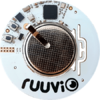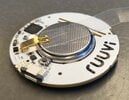Since i knew i had to remove modules and disconnect coolant hoses, i had to drain it, instead of making a mess later in the case.
I followed wk057's suggestion to just insert hoses on the inside to open the valves.
One hose pushing the air in, out the other coolant comes out to a bucket. I was careful but better to use regulated air, coolant system is not designed to be more than 5psi i think.
Silicon hoses were just the right diameter and needed to be slightly expanded to seal good.
For air side i just inserted the fitting and cut out the sides for air.
For coolant one, i put one of those nipples from compression fitting and bent the sides to let the coolant through.
About 1gal came out.
For refilling, i had to push air into the jug and have another hose going into empty one, cause some coolant would go through. Had to do this twice to get most of coolant in. For this reason, vacuum fill didn't work.
I wanted to check for leaks after so i left the pack open and had to cover work area with plastic. I also pressurized the system to 5psi to be sure and nothing leaked.
Coolant valves are sealed with black silicone to the penthouse cover, i'm guessing since its more oil resistant.
This was much harder to separate, u have to be careful not to break anything
When i installed unsealed battery for testing, i cut out a gasket for this from cork material and taped all nearby screw holes in case coolant leaks.
I'm glad i did, cause depending on how fast you raise/lower the battery, some coolant spills, i had a small puddle but nothing went into the battery.
Removing coolant lines from modules was straight forward but challenging due to lack of space.
Plastic tubes are really hard and don't bend well.
Right side is easy since its on top but left side didn't have enough slack and i didn't want to bend too much so i found it was easier to lift the module a bit (~1/2in). I used roll of electrical tape stuck between frame and yellow casing to hold the module raised. I disconnected right side, unlatch the left side, raise the module then pull off left side.
Don't have exact pic but you get the idea. Left side circled.
Some coolant would still spill when disconnecting, so i put a paper towel underneath to catch it.
Not super critical when removing modules but when installing you wanna keep the pack dry and clean.
Once modules were removed some coolant would still drip and also to protect the surface, i used rubber end caps to cover it up.
These are great to have in your toolbox or junk drawer anyways.





